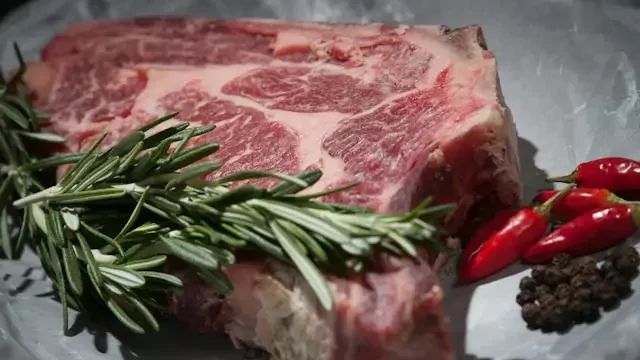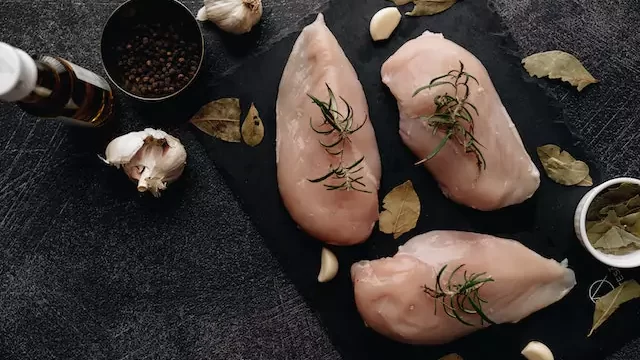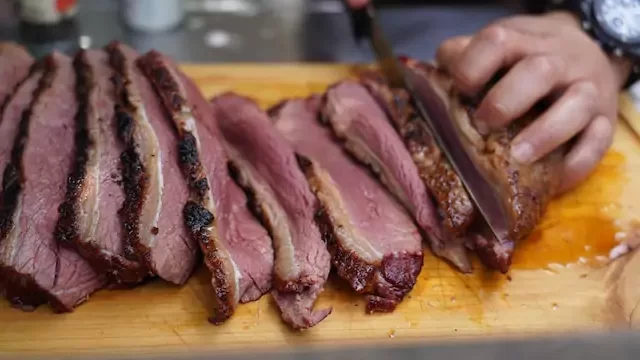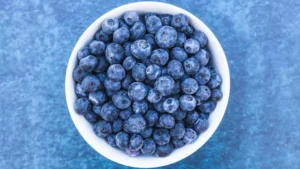Protein is an essential nutrient for muscle growth and repair. When you eat protein, your body breaks it down into amino acids, which are the building blocks of muscle tissue. After a workout, your muscles need protein to rebuild and repair themselves, which is why it’s important to include protein in your post-workout meal.
When choosing a high-protein meat, it’s important to look for one that is low in fat and calories. You should also choose a meat that is a good source of all nine essential amino acids. The five meats listed below are all excellent sources of protein and other essential nutrients that can help you build muscle.
Related: The Best Meal to Eat After Training

Chicken Breast
Chicken breast is one of the most popular cuts of chicken, and for good reason. It’s a lean protein source that is low in calories and fat, and it’s a good source of all nine essential amino acids. Essential amino acids are those that your body cannot produce on its own, so you need to get them from your diet.
Chicken breast is a good choice for people who are trying to build muscle, lose weight, or simply eat a healthy diet. It’s also a versatile food that can be cooked in a variety of ways, such as grilling, baking, roasting, or frying.

Nutritional Information
A 3-ounce (85g) serving of cooked chicken breast contains approximately:
- Calories: 128
- Protein: 26 grams
- Fat: 3 grams
- Carbohydrates: 0 grams
Protein Utilization
The amount of protein that your body can use from a food source is called its protein utilization score (PDIAS). The PDIAS for chicken breast is 0.92, which means that your body can use 92% of the protein in chicken breast.
This is higher than the PDIAS for many other protein sources, such as eggs (0.91), beef (0.88), and pork (0.85). This means that chicken breast is a very good source of bioavailable protein, which means that your body can easily absorb and use it.
How to Include Chicken Breast in Your Diet
There are many ways to include chicken breast in your diet. Here are a few ideas:
- Add it to salads or sandwiches
- Grill, bake, or roast it and serve it with vegetables
- Use it in stir-fries or soups
- Add it to pasta or rice dishes
Chicken breast is a versatile food that can be enjoyed in many different ways. Be sure to include it in your diet as a good source of protein and other essential nutrients.
Turkey Breast
Turkey breast is another excellent source of high-protein meat. It’s similar to chicken breast in terms of its nutritional profile, but it’s slightly higher in calories and fat. Turkey breast is also a good source of selenium, which is an important antioxidant.

Nutritional Information
A 3-ounce (85g) serving of cooked turkey breast contains approximately:
- Calories: 145
- Protein: 26 grams
- Fat: 4 grams
- Carbohydrates: 0 grams
Protein Utilization
The protein utilization score (PDIAS) for turkey breast is 0.91, which means that your body can use 91% of the protein in turkey breast.
This is slightly lower than the PDIAS for chicken breast, but it’s still very high compared to other protein sources. This means that turkey breast is a very good source of bioavailable protein, which means that your body can easily absorb and use it.
How to Include Turkey Breast in Your Diet
There are many ways to include turkey breast in your diet. Here are a few ideas:
- Add it to salads or sandwiches
- Grill, bake, or roast it and serve it with vegetables
- Use it in stir-fries or soups
- Add it to pasta or rice dishes
Turkey breast is a versatile food that can be enjoyed in many different ways. Be sure to include it in your diet as a good source of protein and other essential nutrients.
Benefits of Turkey Breast
In addition to being a good source of protein, turkey breast also offers a number of other health benefits, including:
- It’s low in saturated fat and cholesterol
- It’s a good source of vitamins and minerals, such as selenium, phosphorus, and niacin
- It’s a relatively affordable and accessible food
Tips for Cooking Turkey Breast
When cooking turkey breast, it’s important to avoid overcooking it, as this can make it dry and tough. Here are a few tips:
- Use a meat thermometer to ensure that the turkey breast is cooked to an internal temperature of 165 degrees Fahrenheit.
- Baste the turkey breast with cooking oil or broth during cooking to help prevent it from drying out.
- Let the turkey breast rest for a few minutes before slicing and serving. This will help the juices redistribute throughout the meat, making it more tender and flavorful.
Lean Beef
Lean beef is a good source of high-protein meat. It’s also a good source of iron, zinc, and creatine. Creatine is a natural substance that helps to improve muscle strength and power. When choosing lean beef, look for cuts that are 90% lean or higher.

Nutritional Information
A 3-ounce (85g) serving of cooked lean beef contains approximately:
- Calories: 170
- Protein: 26 grams
- Fat: 5 grams
Protein Utilization
The protein utilization score (PDIAS) for lean beef is 0.88, which means that your body can use 88% of the protein in lean beef.
This is slightly lower than the PDIAS for chicken breast and turkey breast, but it’s still very high compared to other protein sources. This means that lean beef is a very good source of bioavailable protein, which means that your body can easily absorb and use it.
How to Include Lean Beef in Your Diet
There are many ways to include lean beef in your diet. Here are a few ideas:
- Add it to salads or sandwiches
- Grill, bake, or roast it and serve it with vegetables
- Use it in stir-fries or soups
- Add it to pasta or rice dishes
Tips for Cooking Lean Beef
Here are a few tips for cooking lean beef:
- Use a meat thermometer to ensure that the beef is cooked to an internal temperature of 160 degrees Fahrenheit for medium or 145 degrees Fahrenheit for medium rare.
- Cook the beef over medium heat to prevent it from drying out.
- Baste the beef with cooking oil or broth during cooking to help it stay juicy.
- Let the beef rest for a few minutes before slicing and serving. This will help the juices redistribute throughout the meat, making it more tender and flavorful.
Benefits of Lean Beef
In addition to being a good source of protein, lean beef also offers a number of other health benefits, including:
- It’s a good source of iron, which is important for transporting oxygen throughout the body.
- It’s a good source of zinc, which is important for immune function and wound healing.
- It’s a good source of creatine, which helps to improve muscle strength and power.
Conclusion
Lean beef is a good source of protein and other essential nutrients. It’s a versatile food that can be enjoyed in many different ways. Be sure to include lean beef in your diet as part of a healthy diet.
Salmon
Salmon is a high-protein meat that is also a good source of omega-3 fatty acids. Omega-3 fatty acids have anti-inflammatory properties and can help to improve muscle recovery. Salmon is also a good source of vitamin D, which is important for bone health.

Nutritional Information
A 3-ounce (85g) serving of cooked salmon contains approximately:
- Calories: 206
- Protein: 25 grams
- Fat: 13 grams
- Carbohydrates: 0 grams
Protein Utilization
The protein utilization score (PDIAS) for salmon is 0.92, which means that your body can use 92% of the protein in salmon.
This is the same as the PDIAS for chicken breast, and it’s higher than the PDIAS for many other protein sources. This means that salmon is a very good source of bioavailable protein, which means that your body can easily absorb and use it.
How to Include Salmon in Your Diet
There are many ways to include salmon in your diet. Here are a few ideas:
- Grill, bake, or roast salmon and serve it with vegetables
- Use salmon in stir-fries or soups
- Add salmon to salads or sandwiches
- Make salmon burgers or salmon tacos
Tips for Cooking Salmon
Here are a few tips for cooking salmon:
- Cook salmon over medium heat to prevent it from drying out.
- Don’t overcook salmon, as this can make it dry and tough.
- Baste the salmon with cooking oil or butter during cooking to help it stay moist.
- Let the salmon rest for a few minutes before slicing and serving. This will help the juices redistribute throughout the meat, making it more tender and flavorful.
Benefits of Salmon
In addition to being a good source of protein and omega-3 fatty acids, salmon also offers a number of other health benefits, including:
- It’s a good source of vitamin D, which is important for bone health.
- It’s a good source of vitamin B12, which is important for energy production and red blood cell formation.
- It’s a good source of selenium, which is an antioxidant that can help to protect your cells from damage.
Conclusion
Related: 10 High Protein Seafood Options for Fitness
Salmon is a high-protein meat that is also a good source of omega-3 fatty acids and other essential nutrients. It’s a versatile food that can be enjoyed in many different ways. Be sure to include salmon in your diet as part of a healthy diet.
Bison
Bison is a lean meat that is high in protein and iron. It’s also a good source of zinc and selenium. Bison is similar to beef in terms of its flavor, but it’s slightly lower in calories and fat.

Nutritional Information
A 3-ounce (85g) serving of cooked bison contains approximately:
- Calories: 156
- Protein: 25 grams
- Fat: 6 grams
Protein Utilization
The protein utilization score (PDIAS) for bison is 0.93, which means that your body can use 93% of the protein in bison.
This is the highest PDIAS of any of the meats we’ve discussed so far. This means that bison is an excellent source of bioavailable protein, which means that your body can easily absorb and use it.
How to Include Bison in Your Diet
There are many ways to include bison in your diet. Here are a few ideas:
- Grill, bake, or roast bison and serve it with vegetables
- Use bison in stir-fries or soups
- Add bison to salads or sandwiches
- Make bison burgers or bison tacos
Tips for Cooking Bison
Here are a few tips for cooking bison:
- Cook bison over medium heat to prevent it from drying out.
- Don’t overcook bison, as this can make it dry and tough.
- Baste the bison with cooking oil or butter during cooking to help it stay moist.
- Let the bison rest for a few minutes before slicing and serving. This will help the juices redistribute throughout the meat, making it more tender and flavorful.
Benefits of Bison
In addition to being a good source of protein and other essential nutrients, bison also offers a number of other health benefits, including:
- It’s a good source of iron, which is important for transporting oxygen throughout the body.
- It’s a good source of zinc, which is important for immune function and wound healing.
- It’s a good source of conjugated linoleic acid (CLA), which is a fatty acid that has been shown to have a number of health benefits, including anti-inflammatory and anti-cancer properties.
Conclusion
Bison is a lean meat that is high in protein and other essential nutrients. It’s a versatile food that can be enjoyed in many different ways. Be sure to include bison in your diet as part of a healthy diet.
FAQs
How much protein do I need to build muscle?
The amount of protein you need to build muscle depends on a number of factors, including your age, sex, activity level, and fitness goals. However, a good general rule of thumb is to aim for 1.2-1.7 grams of protein per kilogram of body weight per day.
When should I eat protein to build muscle?
It’s important to consume protein throughout the day to support muscle growth and repair. However, it’s especially important to eat protein within 30 minutes of finishing a workout. This is because your muscles are most receptive to protein during this time period.
What are some other good sources of protein for muscle building?
In addition to meat, there are a number of other good sources of protein for muscle building, including eggs, dairy products, legumes, and nuts.
What are some tips for cooking high-protein meats?
When cooking high-protein meats, it’s important to use methods that don’t add too much fat or calories. Some good cooking methods include grilling, baking, and roasting. You should also avoid overcooking meat, as this can make it tough and dry.




